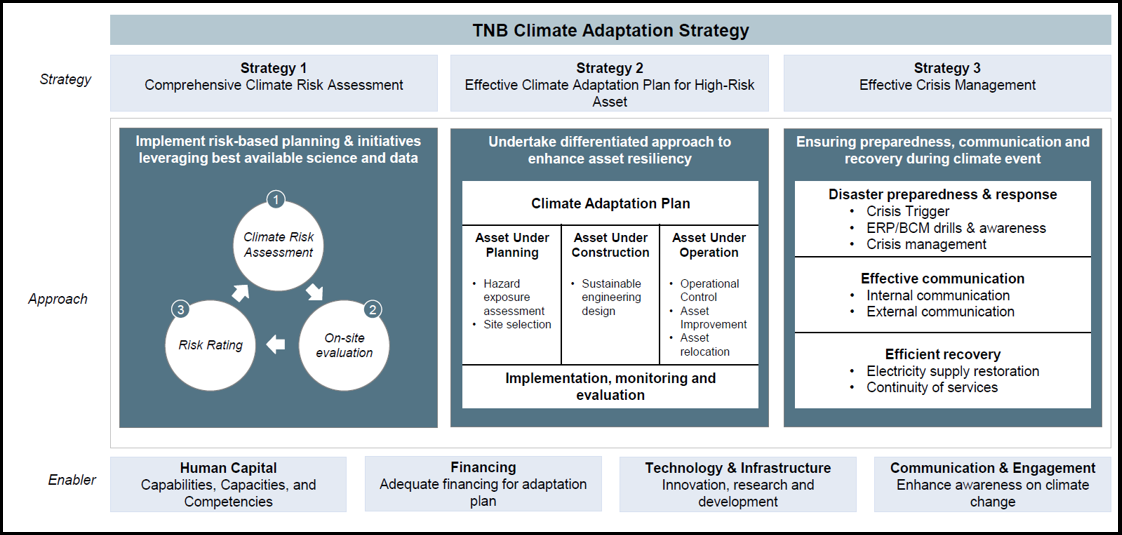(Continuation from Part 1 of the ESG Story – ‘Navigating Climate Change: Our Path to Resilience and Sustainable Energy’, dated 20 March 2025)
Malaysia’s National Climate Change Policy 2.0 (NCCP 2.0) represents a strategic update to the country’s approach to addressing climate change. Launched on 30 September 2024, the policy focuses on enhancing resilience to climate impacts while pursuing a low-carbon future.
Aligning to NPPC 2.0’s Strategic Thrust No.3 “Emphasis adaptation and climate resilience measures that can benefit socio-economic and development goals”, Tenaga Nasional Berhad (TNB) has developed a comprehensive TNB Climate Adaptation Strategy aimed to enhance the resilience of its assets.
TNB Climate Adaptation Strategy
TNB’s Climate Adaptation Strategy anchors itself on three strategic pillars: Comprehensive Climate Risk Assessment, Effective Climate Adaptation Plans, and Effective Crisis Management.

Figure 1: TNB’s Climate Adaptation Strategy
Strategy #1, Comprehensive Climate Risk Assessment, is a critical component for the identification of potential climate exposures and vulnerabilities across TNB assets. The risk assessment evaluates the exposure of assets to climate hazards such as floods, extreme heat, extreme wind, coastal inundation and soil movement.
Subsequently, Strategy #2, Effective Climate Adaptation Plan for High-Risk Asset, focuses on enhancing resiliency of high-risk assets throughout phases in their lifecycle, from planning and construction to operations. The adaptation plan adopts a differentiated approach at each phase, ensuring proactive risk mitigation and long-term sustainability.
Key measures across all asset lifecycle phases include:
Planning
Conducting hazard exposure assessments and strategic site selection to minimise climate-related risks.
Construction
Integrating sustainable engineering designs that enhance structural resilience.
Operation
Implementing stringent operational controls, continuous asset improvements, and, when necessary, asset relocation to minimize unexpected impact of climate hazards.
Implementation of adaptation plans will be closely monitored and reported to management, enabling informed decision-making and ensuring long-term asset sustainability.
Last but not least, Strategy #3, Effective Crisis Management, is intended to safeguard TNB’s assets and continuity of operations from the immediate impact of climate-related events. With effective crisis management, damage to assets is minimised and electricity supply to customers is promptly restored. Emphasis is on the design and implementation of efficient recovery strategies, seamless coordination among various business operations, and robust crisis communication. Proactive crisis management enables TNB to not only manage the immediate fallout from climate-related events but also to implement long-term recovery measures that enhance asset resilience against future occurrences.
Adaptation Plan for Assets Under Operation
A 3-step approach is in place to assess, identify and execute adaptation plans for high-risk assets that are currently operational.

Figure 2: The 3-Step Approach for Identifying and Executing Adaptation Plans for High-Risk Assets
Leveraging on the Geographic Information System (GIS) and climate hazard maps, TNB systematically assesses the exposure of its assets to potential climate-related risks such as floods, extreme temperatures, and storms. A detailed vulnerability assessment follows, incorporating historical climate data and on-site evaluations to determine risk severity. By integrating these insights, assets at high-risk are identified and this forms the foundation for the formulation of targeted adaptation plans.
Adaptation plans are tailored to the specific needs of each asset with a focus on three primary actions: operational control, asset improvement, and, where necessary, asset relocation. For instance, from the vulnerability assessment, assets that could be or have been severely affected by floods may require significant asset improvement plans such as raising the base of the substation or relocating it to a less flood prone location. In contrast, operational controls could be implemented for assets that were not significantly impacted by floods.
| Adaptation Plan | Adaptation Plan Description |
|---|---|
| Asset Relocation | This involves moving critical infrastructure, equipment, or facilities from high-risk areas to safer locations to reduce exposure to climate hazards such as floods, landslides, or rising sea levels. It is implemented when mitigating measures at the existing site are insufficient to ensure long-term resilience. |
| Asset Improvement | This focuses on upgrading, reinforcing, or retrofitting existing infrastructure to enhance resiliency against climate-related risks. It is applied when assets require enhancements to withstand extreme weather conditions. |
| Operational Control | This involves implementing procedural measures, monitoring systems, and emergency response plans to manage climate risks effectively. It focuses on optimising asset operations, enhancing preparedness, and ensuring rapid response to climate-related disruptions. |
Table 1: TNB’s Climate Adaptation Plan for Asset Under Operation
The identified adaptation plans are put into action with careful consideration of factors such as criticality of the equipment and the potential impact on customers, budget and resources. Asset owners are responsible for monitoring and reporting implementation progress in accordance with established governance structures. Climate risk exposure data is updated annually to facilitate a comprehensive climate risk assessment. This cyclical process allows TNB to stay ahead of emerging climate-related risks, adjusting adaptation plans as necessary.
In conclusion, through the Climate Adaptation Strategy, TNB is making significant strides in safeguarding its critical assets against growing threats of climate change. By ensuring that power plants, substations, and other vital infrastructure are resilient, TNB aims to support Malaysia’s transition towards a sustainable and low-carbon future while maintaining a reliable power supply for its customers, even in the face of unprecedented climate challenges.